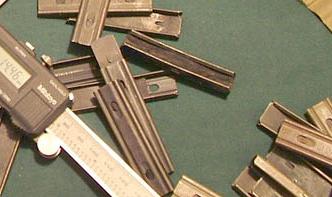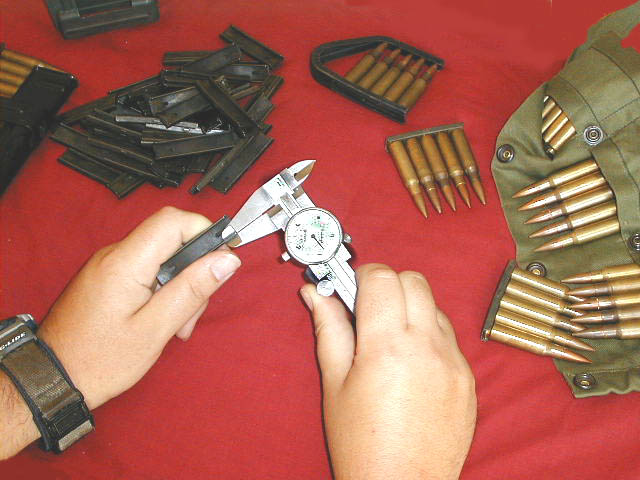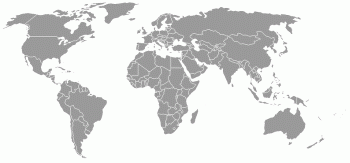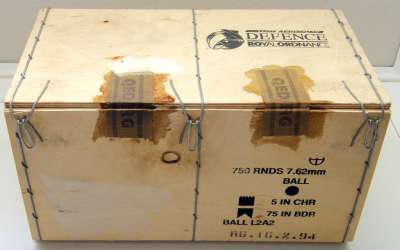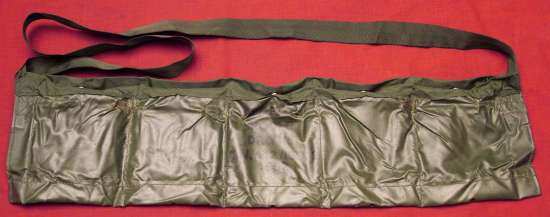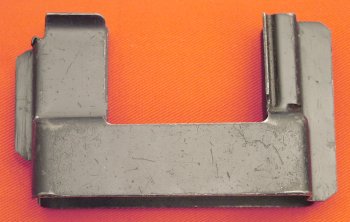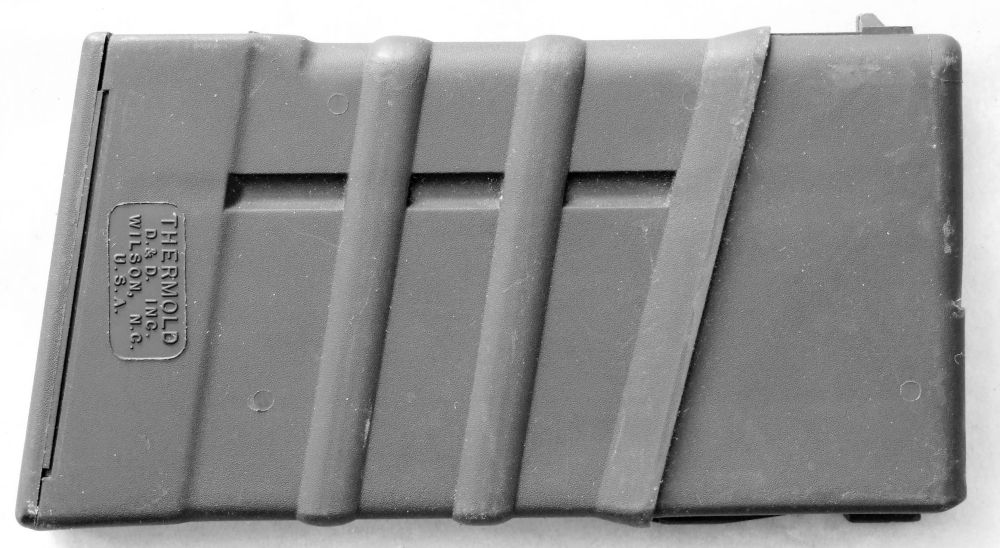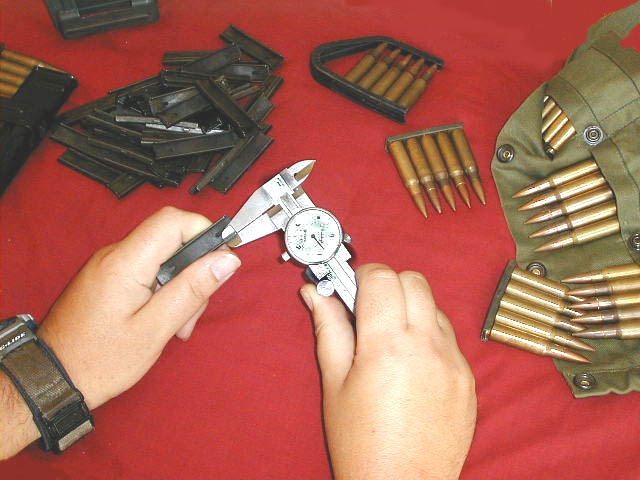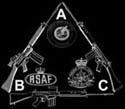|
RESEARCHING
STRIPPER CLIPS
Firstly I must say if you are going to start
researching stripper clips then you are a member of a rare
bred of lunatics. I'm often asked why do I do this and
the only answer that comes to mind is because they (clips) may
all look the same, but there are small minor differences and
when I can't find a rifle to buy I can get as much enjoyment
out of finding the differences between each clip.
Equipment
required
Vernier calipers.
Magnifying glass.
Notebook.
Pen or pencil.
Permanent marker.
Small plastic zip-loc bags, sized 62 x 75 mm & 75
x 130 mm
Oil.
References
Basically none, unfortunately there are very
few references for any sort of stripper clip collecting.
There may be some articles found in some of the
dedicated ammunition collectors magazines. But even with
the advent of the Internet I believe this is the only web site
dealing in any way with the 7.62 x 51 mm NATO stripper clip.
If you have any links or paper reference sources could
you please let me know.
Classifying
and Identify your 7.62 mm NATO Stripper Clips
This is a tricky subject and is
open to a lot of speculation. Until recently I had to make an
educated guess as to the various marks of British, Canadian
and Australian stripper clips (" Chargers " in British service).
Information obtained from the British List of Changes in War Materials (LoC) confirms my theories relating to
the various marks of British stripper clips and in turn this
relates in some way to the marks of Australian and Canadian
clips.
If anyone has any official
references to the mark, model or version for USA, Canadian or
any other counties stripper clip or charger, please could you
contact me.
Another source of information on
the Australian, British and Canadian clips are the obscure
entries in the Minutes of the RSC (Rifle Steering Committee).
Contained within the pages of the minutes are statements about
the production, trials and deficiencies in relation to
stripper clips and bandoleers.
If you have a number of stripper
clips in your collection in which you are unsure of the origin
of them and they have no markings then the only thing you can
do is study the clips closely looking for any differences in
the way its manufactured and then comparing them to know
country examples.
Storage
I have found that if you are accumulating a lot
of stripper clips and you want to be able to access the clips
for reference, swapping, trading or selling then you need to
keep the countries and sometimes the individual markings
separate. A good way of doing this is using small
zip-loc bags to store the different clips in.
For individual differently marked
clips I store them in 'country bags' and for duplicates I
store them in individually markings bags inside a larger
country bag. More effort has to given to your duplicates
because it will be these that you are going to need to find
for swapping. It is a pain in the neck having to go
through 100 clips to find one differently marked clip for
swapping purposes.
A light coating of oil such as
CRC's 'LONG LIFE' will prevent rusting to your prized
items. LONG LIFE is a better product to use rather then
the standard CRC 556 as this product will evaporate removing
with it any traces of oil on the stripper clip. LONG
LIFE applies a coating that encapsulates the metal which
doesn't evaporate and is easier to apply then standard oil.
Tales
from the RSC (Rifle Steering Committee)
Many of you will not know who the
RSC were, they consisted of representatives from the UK,
Canada, Australia, FN and in the later stages New Zealand. The
whole purpose of the committee was to ensure that there would
be a set standard of production between the manufacturing
countries and interchangeability between the main components
and sub assemblies. New ideas were rigorously trialled and
tested amongst the participating countries, some went into
production others never made it past trials. The Minutes of
the RSC are a gold mine of information pertaining to the
introduction of new ideas, trials and tests and changes to the
production standards, for example:-
The following has been extracted from the
minutes of the 6th meeting of the RSC and is dated 18-19
November, 1957:-
|
CHARGERS (D.S.C.
2.29)
68
The
Australian User pointed out that at the present time
with their policy on ammunition they did not feel
qualified to agree with the
recommendation that the Chargers (Canadian type) be
made R.S.C. standard.
69
The
Australian User also pointed out that it was most
important that they be able to top load Canadian,
U.K., American and
Australian ammunition with clips used by the various
countries mentioned.
70
It
was AGREED that U.K. and Canada standardize outside
the R.S.C. on the Canadian drawing.
71
It
was AGREED that the R.S.C. Secretary again inform
the
M.A.S. Committee on Links and Chargers that it is
the wish charger among
all countries in N.A.T.O. at the earliest possible
date.
|
DESIGN
SUB-COMMITTEE ENTRY
| 2.29 |
Chargers
(B-DAD,102301A) |
(a) |
U.K. suggested that in view
of the fact that
both
U.K. and Canada were using the Canadian
1
pip type charger that is should become an R.S.C.
standard. |
(a)
|
It was agreed that this
matter
be referred to the main meeting
for a decision as to whether this
matter should be referred to the
MAS Working Party on Links and
Chargers. |
|
|
(b) |
U.K. request deletion of the
0.3 + .01 radius on the body Charger (DAD.102299). |
(b)
|
Canada will investigate this
point. |
| |
|
(c) |
U.K.
submitted a Thomas French alternative pattern
charger (one each for Australia and Canada).
Canada and Australia requested a further 100
samples each. |
(c)
|
U.K. agree to supply samples |
| |
|
|
|
|
|
The following has been extracted from the
minutes of the 9th meeting of the RSC and is dated 14-15
November, 1960:-
12.1 CHARGER,
5 ROUND
12.1 U.K -
Present Position on T. French one-piece design
U.K. -
Trials in U.K. indicate complete satisfaction
in magazine filling and top loading. Samples of the
latest design should be available soon for Canada
and Australia if they are required. Finalized
drawings were tabled by U.K. New Zealand, Canada
and Australia
each
request 1,000 samples.
12.2 U.K -
Results of Tests on Canadian Samples
Canadian
samples not yet received by U.K.
12.3 Canada
- Status of Development
Canadian
design has not been completed. Material
and dimensions require adjustment. Samples should
be available for U.K. and Australia in the near
future. The plastic material precludes corrosion
and should be approximately 50% cheaper. U.K. and
Australia confirm request for 5,000 each. New
Zealand requests 1,000. All chargers should
conform to STANAG gauge dimensions.
12.4 Australia
- Current Position
Australia
have assessed the U.K. Mk. III design.
The spring has been modified to improve the push-
out load. Production is now well in hand.
British
List of Changes in War Materials (LoC)
The following are extracted
from the LoC's which is the official register of equipment in
British service and details the introduction, modification and
obsolescent of military service equipment.
C 8827
CHARGERS, 7.62 MM. AMMUNITION, MK. 1 (Cat. No. Q2/QV 16A)
To hold five rounds ; horse-shoe type
.................................................................
L
1.
INTRODUCTION.
2.
OBSOLESCENT.
CHARGERS, 7.62
MM. AMMUNITION
To
hold five rounds
MK. 2 (Cat. No. Q2/QV 21A)
Springfield type
......................................................................................
L
Mk. 3 (Cat No. Q2/QV 20A)
.....................................................................
L
3. NEW
PATTERNS.
1 and 2. A
drawing (QV 16A) has been sealed to govern manufacture of
the
above-mentioned charger, which is hereby formally introduced
for use in Land
Service and declared obsolescent.
Drawings (QV 21A
and QV 16A, respectively) have been sealed to govern
manufacture of the above-mentioned new pattern chargers,
which are hereby
introduced for use in Land Service.
The Mk. 2
charger (QV 21A), of steel, is provided with a spring for
retention of
the rounds and is suitably shaped for insertion into the
Adaptor magazine
charging 7.62 mm.
The Mk. 3
charger (QV 20A), also of steel, is generally similar to the
Mk. 2
charger described above, differing mainly in that it is
provided with only one
detent on each of the frame instead of two.
Both chargers are marked with the contractor's initials or
recognised trade
mark and the year of manufacture.
5th
Aug, 1958-57/Vocab./6760
24th April, 18th June, 29th July, 1957-M.N./141/02
I.A. -F/188, F/193
C 9289
CHARGER, 7.62 mm. AMMUNITION, MK. 2 (Cat. No. Q2/QV 21A)
...................... LN
OBSOLESCENT.
The
above-mentioned ammunition charger (§§ C 8826, C 8827) is
hereby declared
obsolescent.
19th
Mar., 1959-57/Vocab./6960
3rd Oct., 1958-M.N./141/02
10th Dec., 1958-W. 17965/58
I.A. -F/251
C 9809
CHARGERS, 7.62 MM. AMMUNITION, MK. 4 (Cat. No. Q2/QV 66)
To hold five rounds
...........................................................................................
L
INTRODUCTION.
A drawing (QV
66) has been approved to govern manufacture of the above-
named charger, which is hereby introduced in Land Service as
an alternative
to the Mk. 3 (§§ C 8826, C 8827) from which it principally
differs in being
manufactured in one piece only.
The charger is stamped QV66, the manufacturers code number
and year of
manufacture in 1/8 in. type.
8th
Mar., 1961-57/Vocab./7533
16th Nov., 1960-M.N./141/04
I.A. -F/316
D 287
CHARGER, 7.62 MM. AMMUNITION, MK. 4 (Cat. No. Q2/QV 66)
To hold five rounds
..........................................................................................
LN
EXTENSION
OF USE.
The
above-mentioned charger (§ C 9809) is hereby extended in use
to Naval
Service and distinguishing letter amended to read as now
shown.
20th
July, 1964-A/57/Vocab./7962
11th June, 1963-G.U.41/47/3
W4/753/63
I.A. -F/316
|
